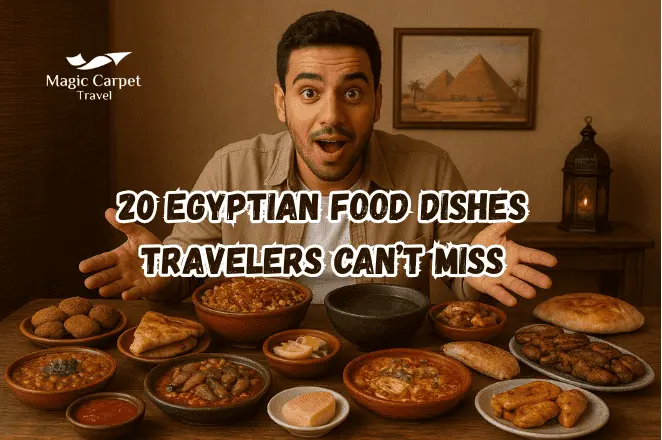You’ll Regret Missing: 20 Traditional Dishes of Egypt
Table of Contents
It’s a disappointment to see the spread of false news of traditional dishes of Egypt, especially when it comes from a prestigious website like “Egypt Adventures Travel”, as it insinuates that Egyptian cuisine isn’t that popular in the U.S.
According to the latest statistics, there are over 165 restaurants in the USA that offer a wide variety of Egyptian dishes that are like no other and much better than other Middle Eastern cuisines that have already included some of them as if they originated in their countries brazenly!
And if you’re planning to visit Egypt, we have prepared for you this thorough guide that will walk you through the many types of traditional Egyptian food, so you may have a few suggestions for eating out in Egypt and have a delicious & authentic trip to Egypt.
In this article, we’ll walk you through the full list of Egyptian popular food for each meal, what makes the traditional dishes of Egypt unique, and tips that you’ll definitely need for eating out in Egypt.
An Overview of Traditional Egyptian Food
In general, each time you try a traditional Egyptian food, you’ll find yourself as if you’re tasting history itself, as each Egyptian dish is at least 300 years old, so every bite is fused with history and flavors.
And this is because no matter how many ages came across Egypt, the Egyptians are attached to their heritage and roots more than any other nation.
For example, while excavations in the ancient Memphis area between the years 2013 and 2014, scientists found a solid whitish mass in a jar that, when analyzed, they found it’s a mixture of goat and cow milk, and dates back to almost 3200 years, making it the world’s oldest cheese!
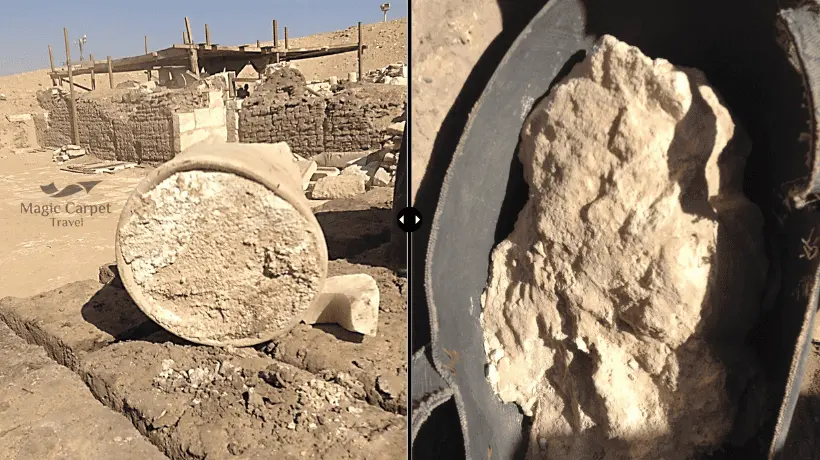
Not only that, but ancient Egyptians also depicted the process of cheese-making on the wall paintings and dating back to 2000 BC, among other food recipes that are still made this very day.
And whenever you think of Egyptian food culture, you’ll find 2 things that characterize it:
A social gathering
It’s not just meal time, it’s the time of the day when family members gather to see each other and keep their humanitarian bond held together.
People used to sit around low tables called “Tablya” or on mats, and mostly eat menu staples like fish, vegetables, bread, and leave chicken and meat for festivals.

Today, more cultural events have been added to the Egyptian calendar, and thus, other chances have become available for gatherings and connecting meals.
For example, during Ramadan, Muslims gather either for Iftar or Suhur, starting the meal with a fresh juice and dates after long fasting times, and ending it with desserts like Konafa and Qatayef.
Also, other occasions are mostly linked with other traditional Egyptian food like family gatherings, weddings, religious feasts (both Islamic and Christian), or even regular friends’ gatherings, all are known for certain Egyptian dishes for every occasion, and reflecting Egypt’s deep-rooted value of humanitarian relationships and hospitality.
Unique Staples for a Unique Flavor
Egyptian food is uniquely known for the staples that are added to the main ingredient of the dish.
And in every meal, herbs leave their signature in the flavor and representing both simplicity and depth.
For example, onion, garlic, coriander, and dill flavor stews in the past much the same way they do now, creating a strong link between the kitchens of the past and the present.
These staples aren’t just recipes — they’re edible symbols of Egyptian identity, passed down through generations.
What Makes Egyptian Food Unique?
Each time you try the Egyptian food, you’ll find it’s like no other.
And this isn’t only the Egyptians’ opinion, but also Christian Berger’s, Head of the EU Delegation to Egypt, as he tried Molokhia, he said that he tried many recipes of it from worldwide, but the Egyptian Molokhia is the best he has ever tasted!
Each meal of the Egyptian dishes dates back thousands of years, and in every bite, you’ll feel a rush that fills your nerves from the unique mixture of flavors, culture, and history.
Besides, here are a few reasons that make traditional Egyptian food and modern Egyptian dishes truly stand out in the worldwide cuisine:
Egypt’s Geography
The fertility of the Egyptian lands provided the right conditions for many of the plants that constitute the Egyptian food, like Wheat & Barley, besides the many legumes like Beans & Lentils.
Also, ancient Egyptians knew how to include all kinds of proteins in the Egyptian cuisine from meat & chicken in everyday meals, along with fish, either from the Nile, the Red Sea, or the Mediterranean Sea, ensuring both nutritional and flavor richness of the traditional Egyptian food.
Seasonal Variety
In Egypt, each season is known for certain dishes that suit the weather.
For example, in winter, Egyptians tend to eat warming Egyptian food like lentils and red sauce dishes, like Koshari, Fattah, Bamia (Okra Stew), and Egyptian pasta.
And in summer, Egyptians tend to foods that are light and keep them refreshed to beat the heat, besides the fresh juices.
But no matter the season, most dishes are customary like Baladi bread, fava beans (ful medames), Taameya, Molokhiya, and much more form the foundation of the traditional Egyptian food and modern favorites.
Correct Use of Spices
Ancient Egyptians knew the different effects of each spice on food and what each dish needed; thus, they created the correct formulations of spices that make your taste buds explode in flavors each time you eat any Egyptian popular food.
For example, coriander adds a fresh earthiness to food, cumin adds warmth, and cinnamon gives a gentle sweetness to the dish. All that helped get the best taste out of the main ingredients of the Egyptian food.
Thus, whenever you try traditional Egyptian food, you’ll find that each dish has its own collection of spices that emphasizes the taste of the dish, like Fava beans (ful medames), Lentil, or Mahshi.
Egyptian Dishes for Each Meal You MUST Try
Egyptian cuisine is known to be very tidy, and certain Egyptian dishes are tied to certain meals throughout the day, unlike some cuisines, where any dish can appear at any time.
And even though each dish is a beauty in itself, Egypt has a wide range of varieties of dishes in each meal, such that you’ll never get bored.
Starting with breakfast and continuing all the way to inner time, you’ll find countless delicacies that you’ll never forget.
Top 20 Traditional dishes of Egypt You Can’t Miss
What Egyptians Eat for Breakfast, Lunch, and Dinner?
Breakfast (Futur)
For Egyptians, breakfast is an energizing meal that boosts them during the day and keeps people full until the afternoon.
Among the common morning Egyptian breakfast dishes are:
- Taameya (Falafel), which is chopped green fava beans and fried until they turn into golden color.
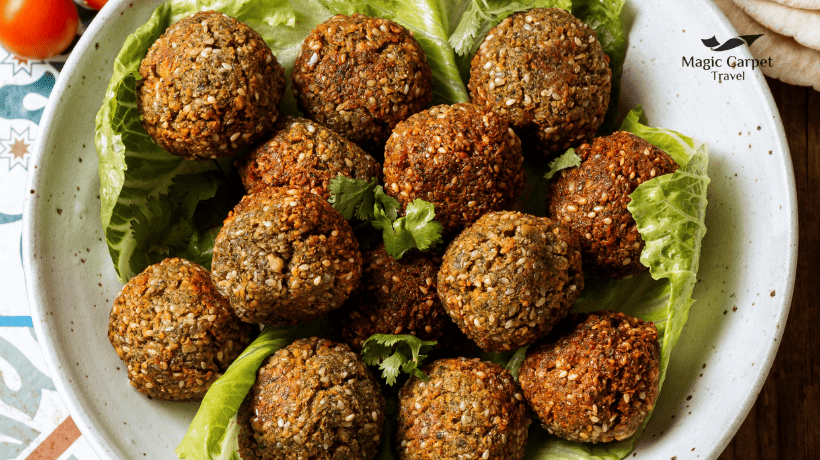
- Ful Medames, which is slowly-cooked fava beans, and flavored with salt, oil, cumin, lemon, and might substitute oil with Tahini.
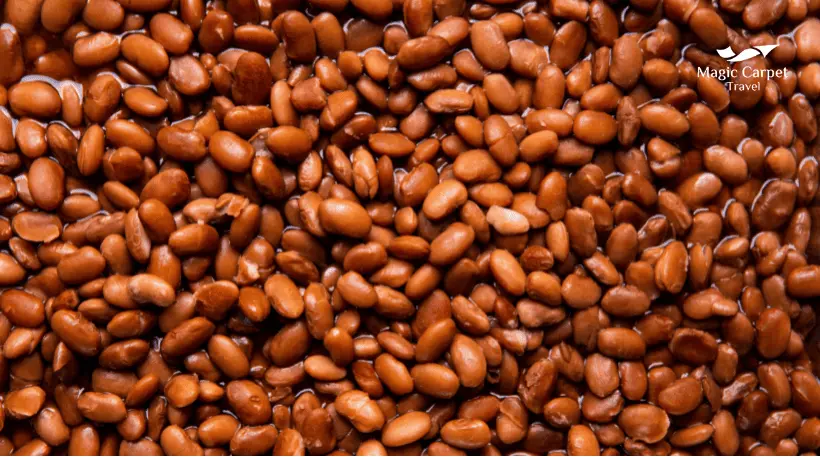
- Aish Baladi (Baladi Bread), which is a type of bread that’s mostly warm, with a rounded shape, and accompanies almost every breakfast dish.
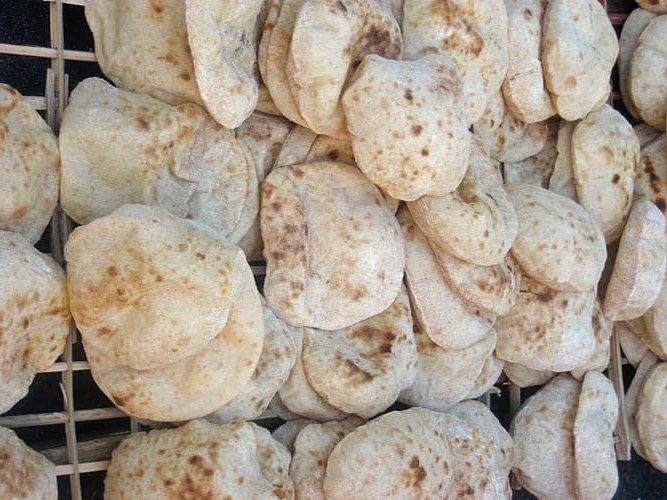
- Areesh Cheese (Cottage cheese) & Tomatoes, a refreshing mixture of White Cheese, and often served with Baladi Bread.
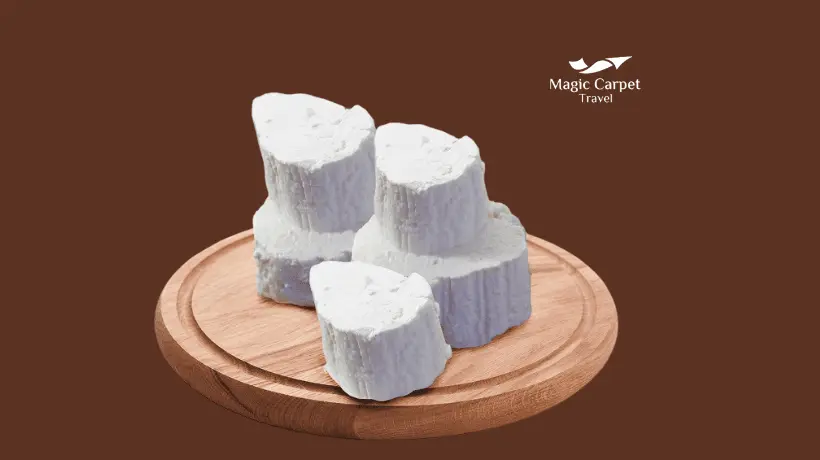
- Shakshuka, among the top traditional dishes of Egypt, consists of boiled eggs and spiced tomato sauce along with onions, garlic, and peppers.
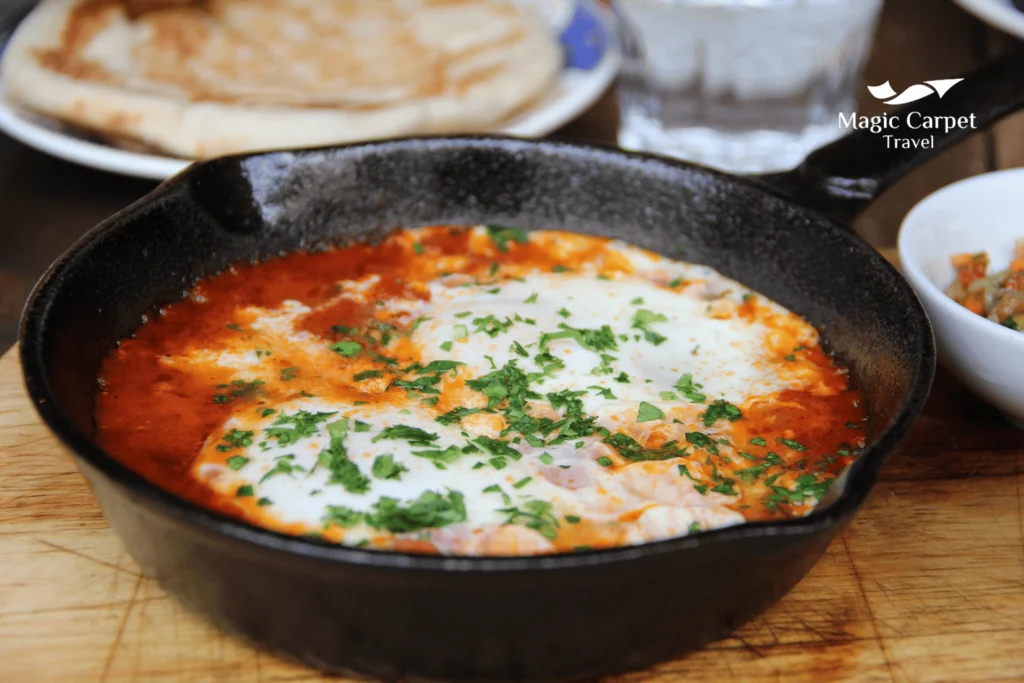
- Eggah, and as the name speak of itself, it is a thick Egyptian dish that consists of omelette and is baked with herbs and spices like pepper, salt, and cinnamon
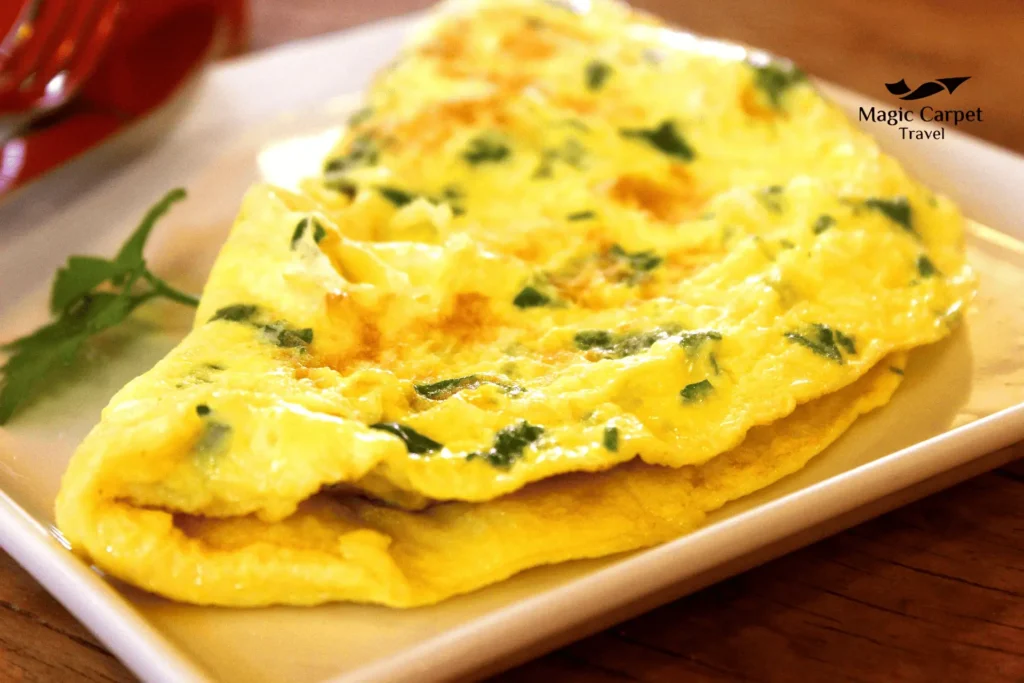
- Pickled vegetables, a popular side dish that makes the breakfast table colorful and a bit salty.
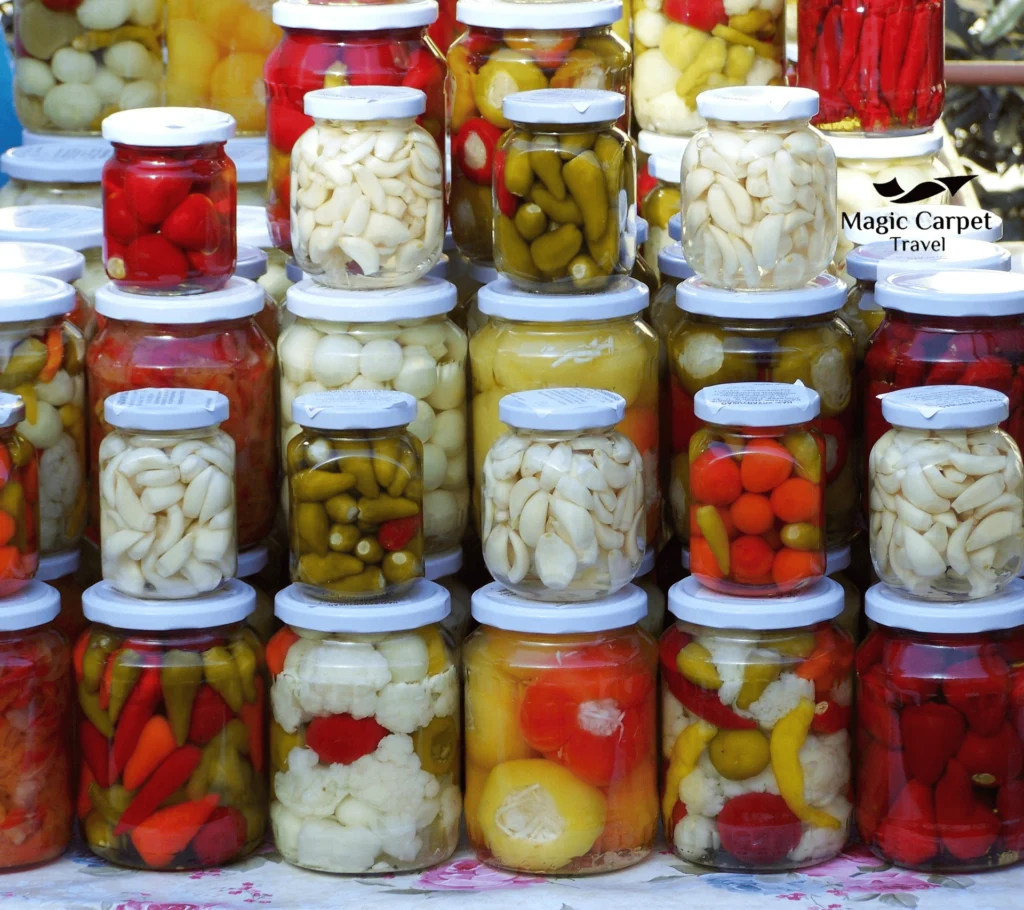
Lunch (Ghada)
Lunch is traditionally known as the most important meal of the day, and where most or all family members share the table.
Among the top traditional dishes of Egypt for lunch:
- Koshary, and it’s considered number Egypt’s most popular food and consists of rice, pasta, lentils, chickpeas, and crispy onions topped with vinegar and tomato sauce.
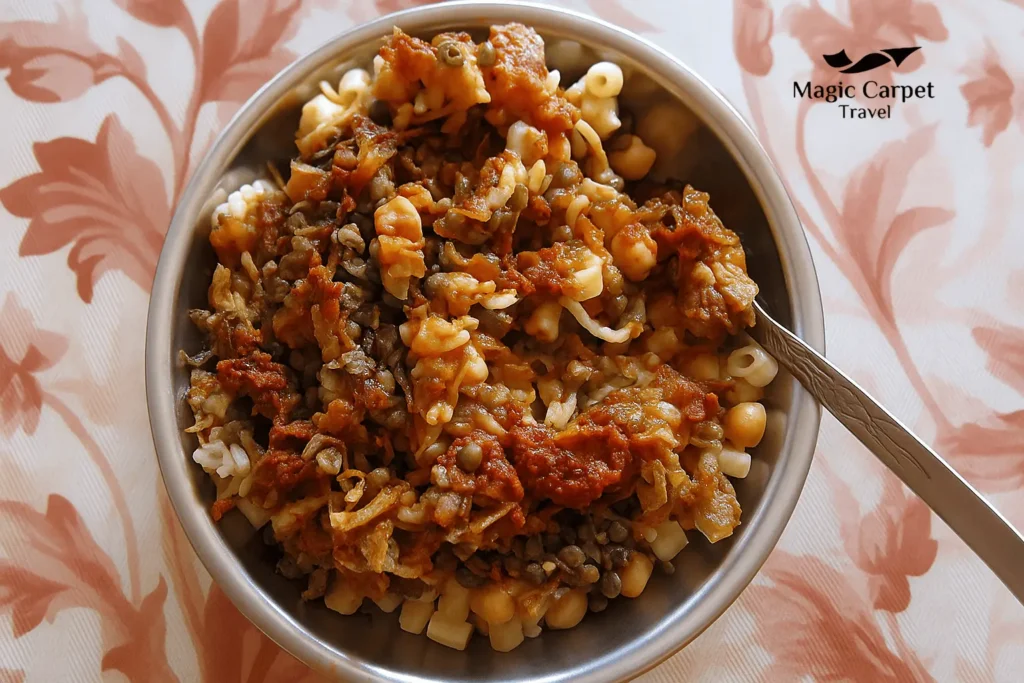
- Molokhia, which is the most Egyptian stew and consists of molokhia leafs cooked with garlic and coriander, and mostly served with either rice or bread.
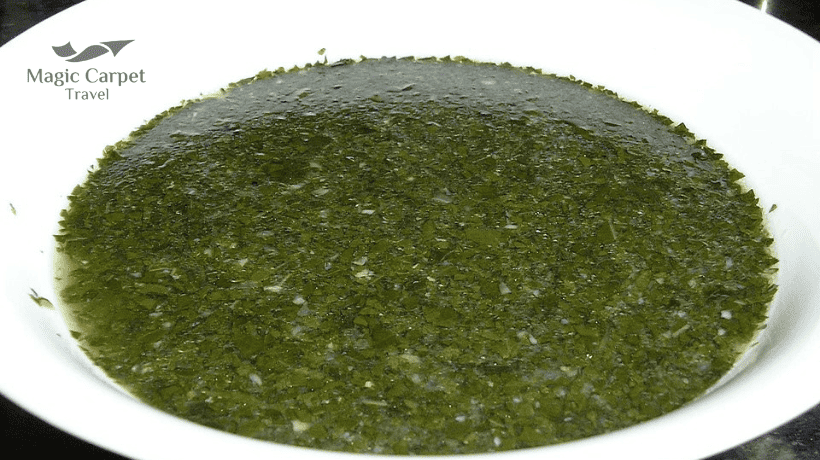
- Okra (Cairo Style), and it’s a tomato-heavy version of okra, where it gets stewed with garlic, tomato paste, and spices, and usually cooked with lamb or beef in the same pottery casserole.
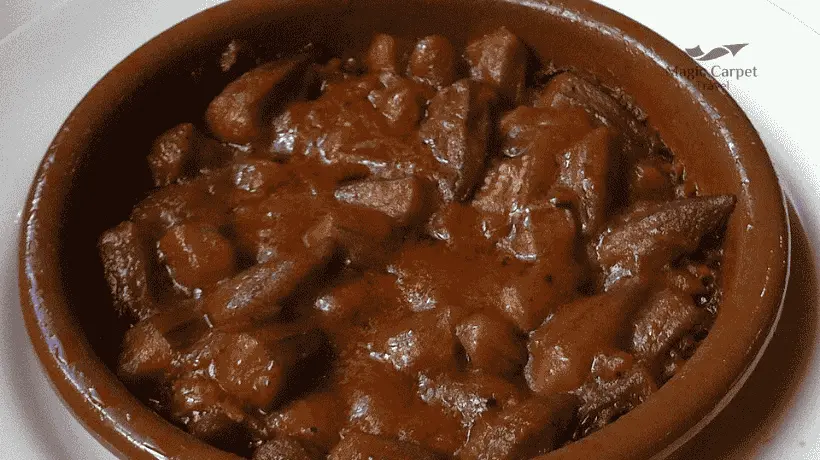
- Okra (Upper Egypt Style), a simpler and more rustic version of okra, where it gets cooked in a garlic-coriander sauce, allowing the okra’s flavor to shine.
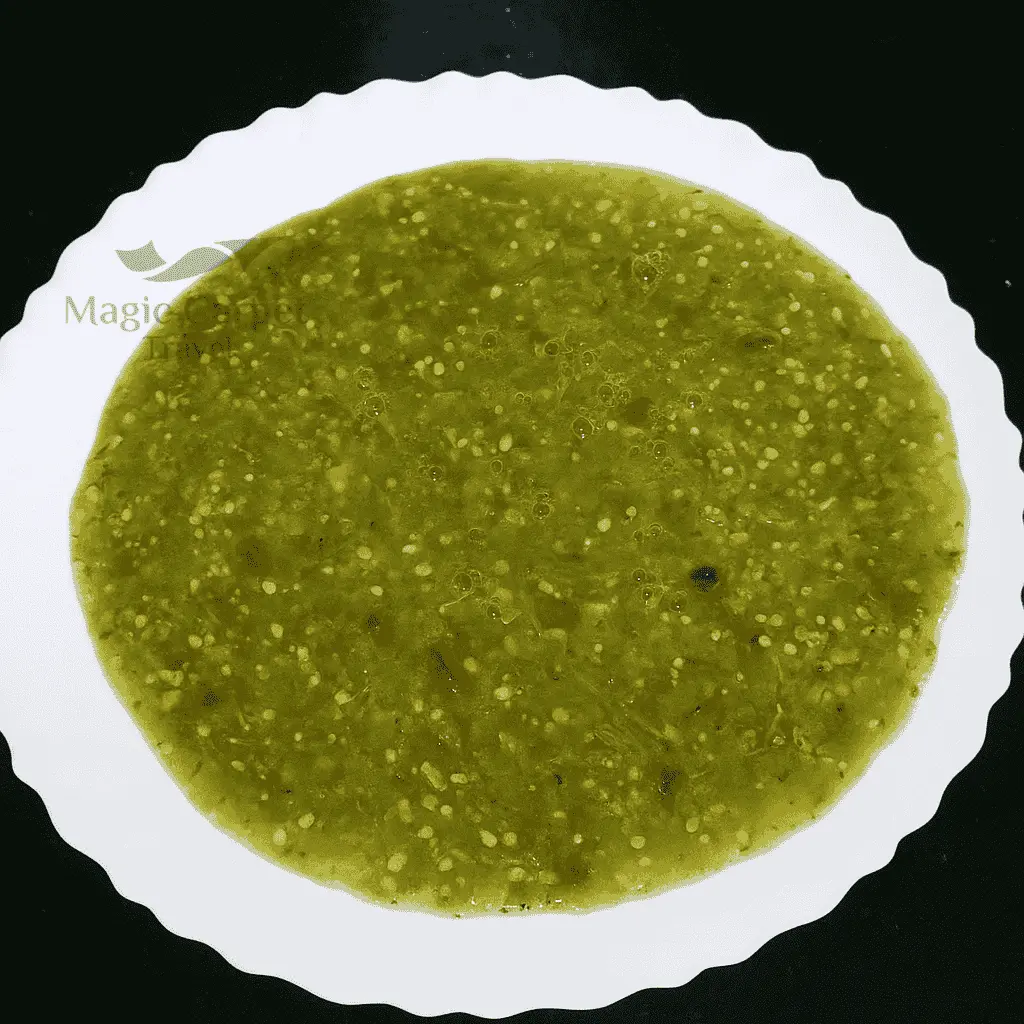
- Mahshi, different kinds of stuffed vegetables like eggplant, zucchini, or vine leaves, and each gets filled with herbs and rice.
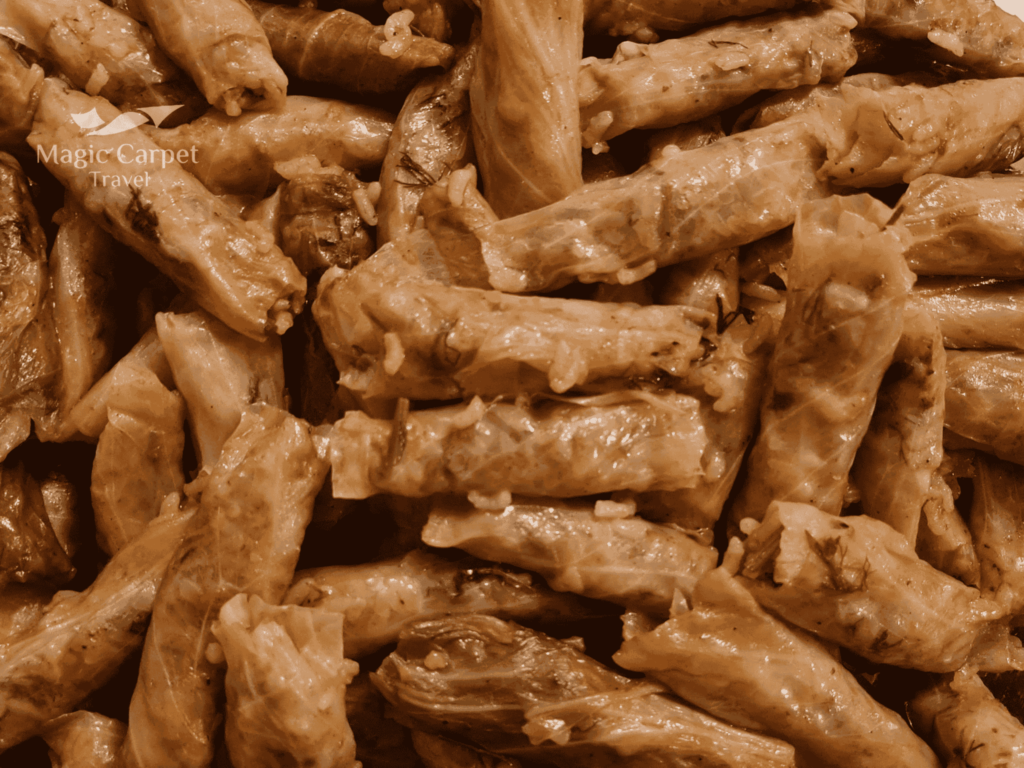
- Grilled Meats (Shish Kabab), a popular dish during festivals and celebrations.
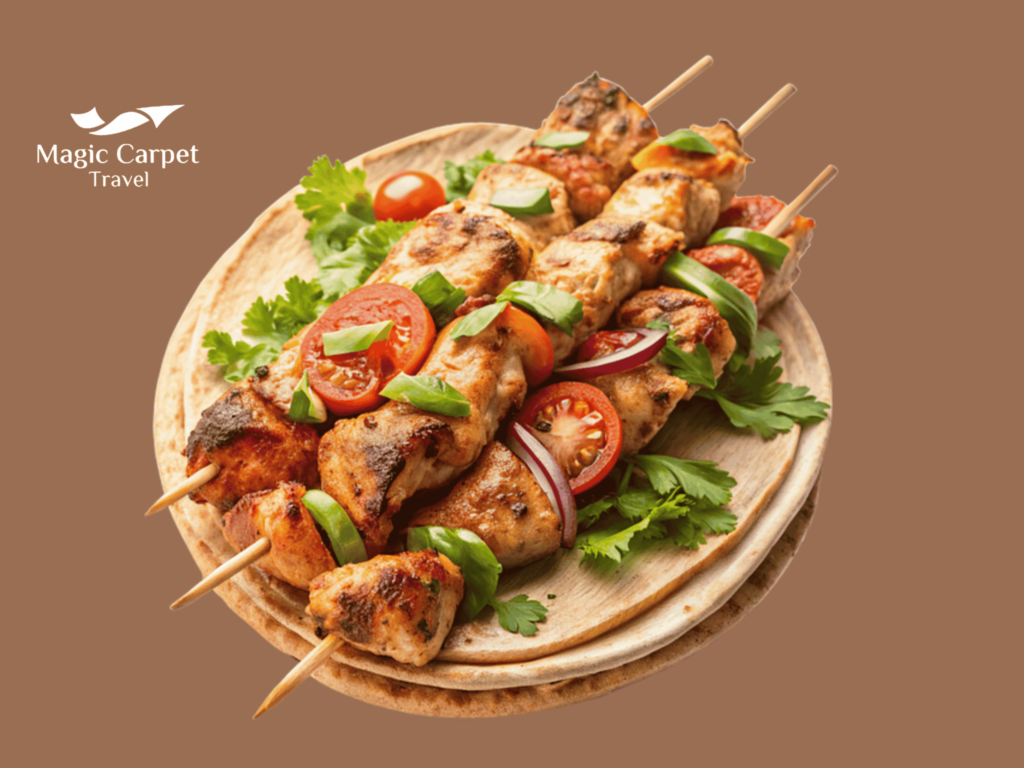
- Fatta, one of the most popular Egyptian food that consists of layers of rice, crispy bread, meat, and broth, and is topped with garlic vinegar sauce.
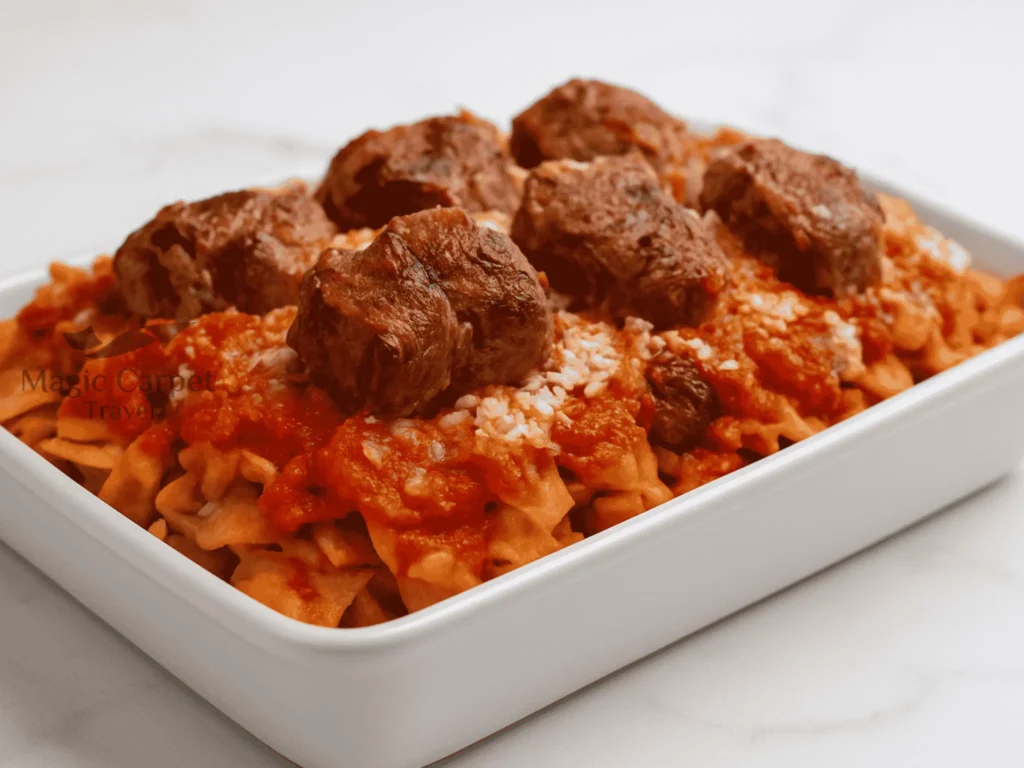
- Seafood, and it’s more related to coastal cities like Alexandria, Hurghada, and Sharm El Sheikh, and consists of grilled fish, seafood soup, shrimps, crabs, crawfish, or fried calamari, usually served with rice and salad.
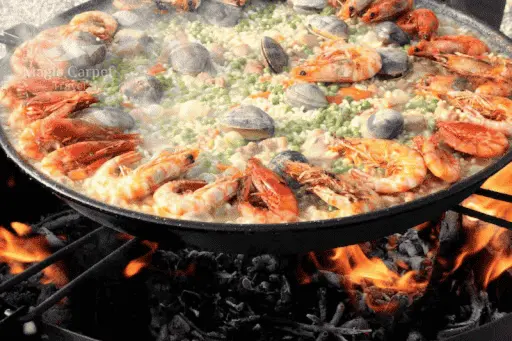
Dinner (Asha)
Dinner is considered the lightest meal in Egypt, though still filling. Mostly, dinner includes some of the most delicious Egyptian dishes, including:
- Hawawshi, which is minced meat baked inside baladi bread.
Hawawshi consists of Aish Baladi filled with meat and vegetables.
- Shawarma rolls, a quick & flavorful Egyptian sandwich of meat or chicken.
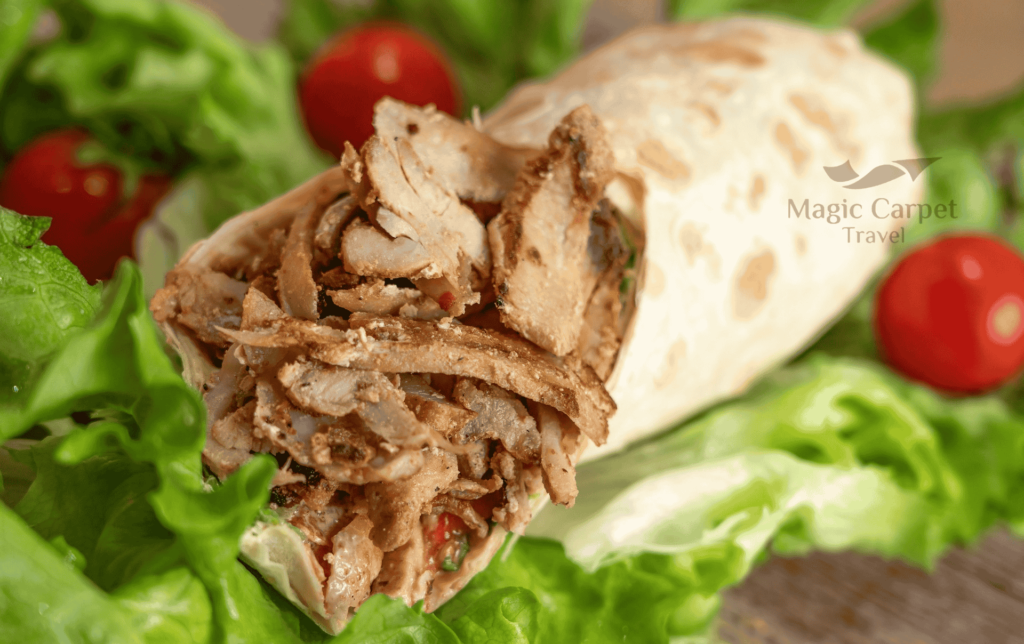
- Kebda Eskandarani (Alexandrian Liver) Sandwich, a grilled & popular street food specialty mostly popular in Alexandria, is made with thin slices of beef liver sautéed with garlic, cumin, peppers, and stuffed into baladi bread.
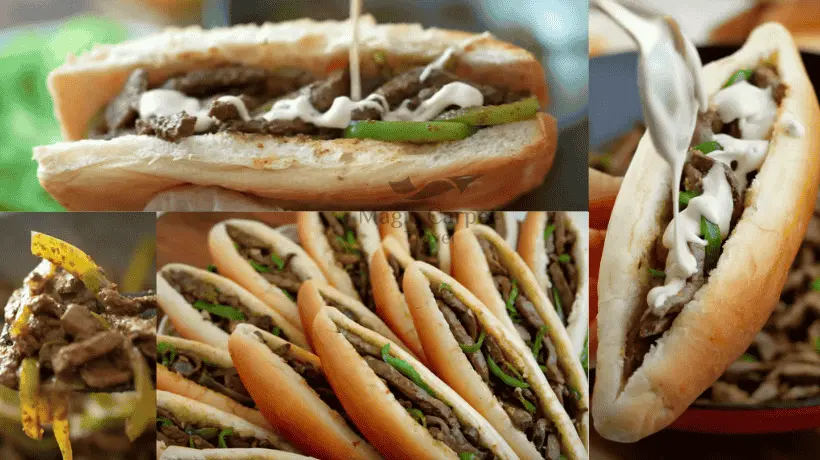
- Lentil Soup (Shorbet Ads), a warming dish that’s mostly popular during the winter.
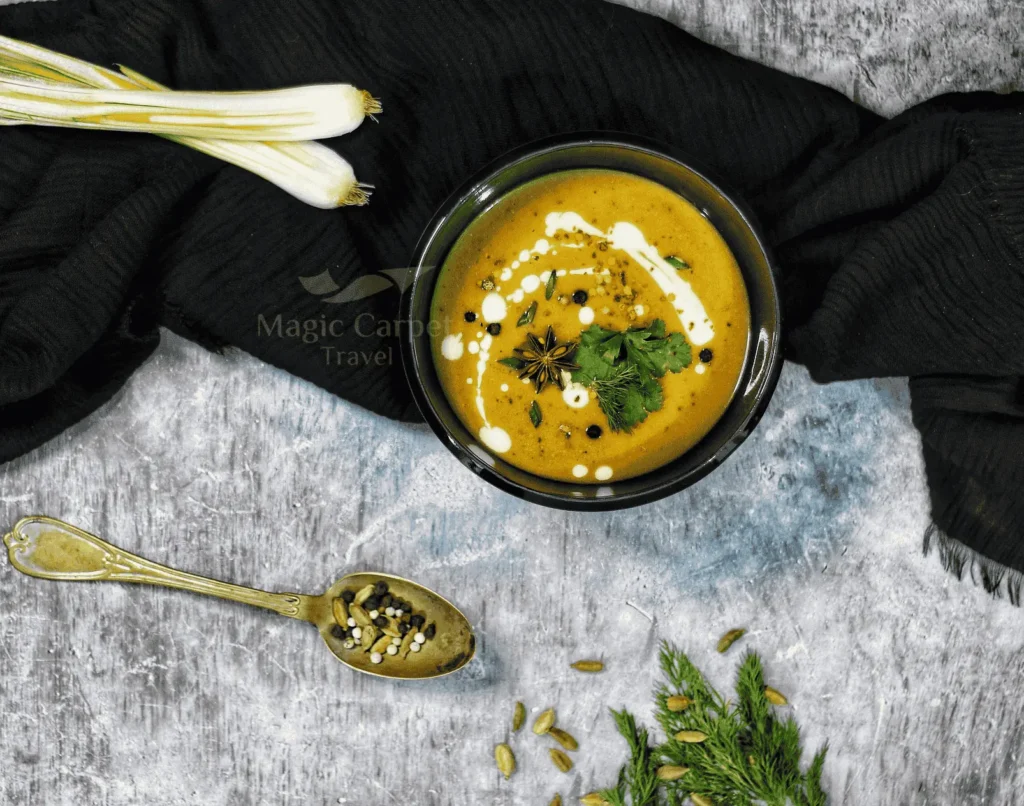
- Cheese, vegetables, and bread, a simple and quick dinner choice for families.
Tips for Travelers for Eating Out in Egypt
If you’re planning to visit Egypt and try different Egyptian popular food, you’d better have some prior knowledge of a few tips to help you be prepared in every possible way in a foreign country and prepare yourself like meal timing, food hygiene, cost of eating out in Egypt, and help you get the most out of such a cultural experience that you’ll see in the hospitality and Egyptians’ traditions.
And to save you time and effort, we prepared some practical tips for each traveler should know before dining in Egypt.
1. Food Prices in Egypt – Cost of Eating Out in Egypt
Food prices range isn’t that much for tourists as most food options are affordable, even at the fanciest places, and it depends on what you’re into:
- Street food: From $1 – $3 (Ful Medames, Taameya, Koshari).
- Mid-range restaurants: From $5 – $10 per person.
- Luxurious dining: From $20 – $40 per person, and this is mostly at hotels, fancy restaurants, and Nile cruises.
2. Best Time for Each Meal
Egyptians’ table is slightly different than what Western travelers may expect:
- Breakfast (7:00 – 10:00 AM): Which is the best time to get a fresh breakfast meal, especially if you’re trying traditional dishes of Egypt like Ful Medames, Taameya, and Baladi Bread, and most locals prefer to grab their sandwiches from street vendors on their way to work.
- Lunch (2:00 – 4:00 PM): It is the time when restaurants are at their busiest time of the day, as it’s the heaviest meal of the day.
- Dinner (8:00 – 10:00 PM): This is the time when you can get a lighter and calmer meal, while enjoying the nighttime vibes of the city.
- Egyptian Street Food Snacks (All Day): And this is when you can get a meal on the go from Koshari shops, juice street vendors, and hawawshi small restaurants that are open almost 24 hours.
3. How to Find Authentic Local Spots
Although restaurants in Egypt can be found on every street and at every corner, there are only a few that can fascinate you with the charm of popular traditional dishes of Egypt, and they are like hidden gems that require searching for.
Here’s where you can find them:
- Look for busy places: If a restaurant has long queues, then it’s a sign that there’s something good around the corner.
- Ask locals: Most people in the neighborhood can lead you to the right places, whether you ask a taxi driver, hotel staff, or your tour guide.
- Avoid touristic traps: Whenever you visit a historical place, you’ll find some close restaurants where they often serve overpriced food with less authenticity. Remember, better options for Egyptian popular food reside only a few meters away.
- Regional specialities: Each city in Egypt is famous for certain dishes. For example, Cairo is known for hidden koshari shops or ta’ameya stalls; in Alexandria, Hurghada, and Sharm El Sheikh are famous of seafood restaurants; and in Luxor, you can enjoy Egyptian grilled corn.
4. Food Hygiene Tips for Tourists
Though the traditional dishes of Egypt are delicious and flavorful, each time you should be aware of your personal hygiene, especially when trying food from street vendors, and in general:
- Avoid drinking from cups from the street water coolers and bring your own cup instead, or you can save yourself the hassle and drink from bottled water.
- Unless the restaurant is trusted, skip salads and choose cooked food over raw.
- Always eat at busy vendors or restaurants, as busy means fresh food.
- Cleanse your hands regularly, either by washing or using a hand sanitizer.
- Be careful with street juice and buy from a trusted shop, or you can stick to bottled juices if unsure.
5. Egyptian Dining Culture
As we mentioned earlier, it’s a whole culture and a social experience:
- Hospitality: Each time you’re invited to eat with Egyptians, you’ll see them insisting you eat more than your dish.
- Sharing: Many people prefer to share their dishes, creating a stronger bond, thus you hear Egyptians say “We’ve broken bread together”.
- Tipping (Baksheesh): which is a small tip (5–10%) of the total price, and it is appreciated everywher,e like restaurants and cafés.
6. Vegetarian & Vegan
If you’re a vegetarian or a vegan, then most of Egypt’s popular food will suit you, such as:
- Ful medames
- Taameya
- Koshari
- Mahshi
- Lentil
- Bamia
- Molokhia
7. Drinks you should try
You can’t visit Egypt and not try its traditional beverages, such as:
- Hibiscus tea (Karkadeh): Either hot or cold.
- Sugarcane juice: Can be found on every street, and it’s a natural energy boost.
- Egyptian coffee & Mint tea: Every coffee shop in Egypt offers both at a very cheap price ($1 – $3)
FAQ
What is Egypt’s most popular food?
Egypt’s most popular food is Koshari, a hearty mix of rice, lentils, pasta, and chickpeas topped with spiced tomato sauce and crispy onions. Widely available as street food, Koshari is considered a staple of traditional Egyptian food and is loved by locals and travelers alike.
What is the famous Egyptian dish?
The most famous Egyptian dish is Koshari. It represents Egyptian street food culture with its affordable ingredients and bold flavors. Other famous traditional dishes of Egypt include Ful Medames (fava beans) and Ta’ameya (Egyptian falafel).
What is the national food of Egypt?
The national food of Egypt is Ful Medames, which is made from slow-cooked fava beans seasoned with olive oil, lemon juice, cumin, and garlic. Eaten mainly for breakfast, Ful is one of the oldest traditional Egyptian foods, dating back to ancient times.
What are three traditional Egyptian dishes?
Three traditional Egyptian dishes are:
- Koshari: Egypt’s national comfort food made of grains and lentils.
- Molokhia: A green stew of jute leaves flavored with garlic and coriander.
- Taameya: Crushed fava beans mixed with herbs like parsley, cilantro, and dill, then deep-fried until crispy.
What is Egyptian bread called?
Egyptian bread is called Aish Baladi, which means “local bread”. It is a round, whole-wheat flatbread similar to pita but thicker and more rustic. Aish Baladi is a cornerstone of every traditional Egyptian food as it is eaten with almost every meal.
What is the national dish of Egypt that is usually eaten at breakfast?
The national dish of Egypt that is often eaten at breakfast is Ful Medames. Made from boiled fava beans with olive oil, lemon, and spices, and it is a nutritious and filling dish. It is the most traditional Egyptian breakfast food and widely enjoyed across the country.
What do Egyptians eat for breakfast?
A traditional Egyptian breakfast usually includes Ful Medames (fava beans), Taameya (Egyptian falafel), Aish Baladi bread, cheese, eggs, and fresh vegetables. These dishes reflect Egypt’s popular food culture and give travelers a taste of authentic, everyday Egyptian cuisine.
What is the most popular drink in Egypt?
The most popular drink in Egypt is black tea, often served strong and sweet. Other widely enjoyed traditional Egyptian drinks include Egyptian Coffee, karkadeh (hibiscus tea), sugarcane juice, and sahlab (a warm milk-based drink). All are staples of Egyptian culture and daily life.
What are the ranges of Egypt food prices?
Egypt’s Food prices range isn’t that much for tourists, as most food options are affordable, even at the fanciest places, and it depends on what you’re into:
- Street food: From $1 – $3 (Ful Medames, Taameya, Koshari).
- Mid-range restaurants: From $5 – $10 per person.
- Luxurious dining: From $20 – $40 per person, and this is mostly at hotels, fancy restaurants, and Nile cruises.

